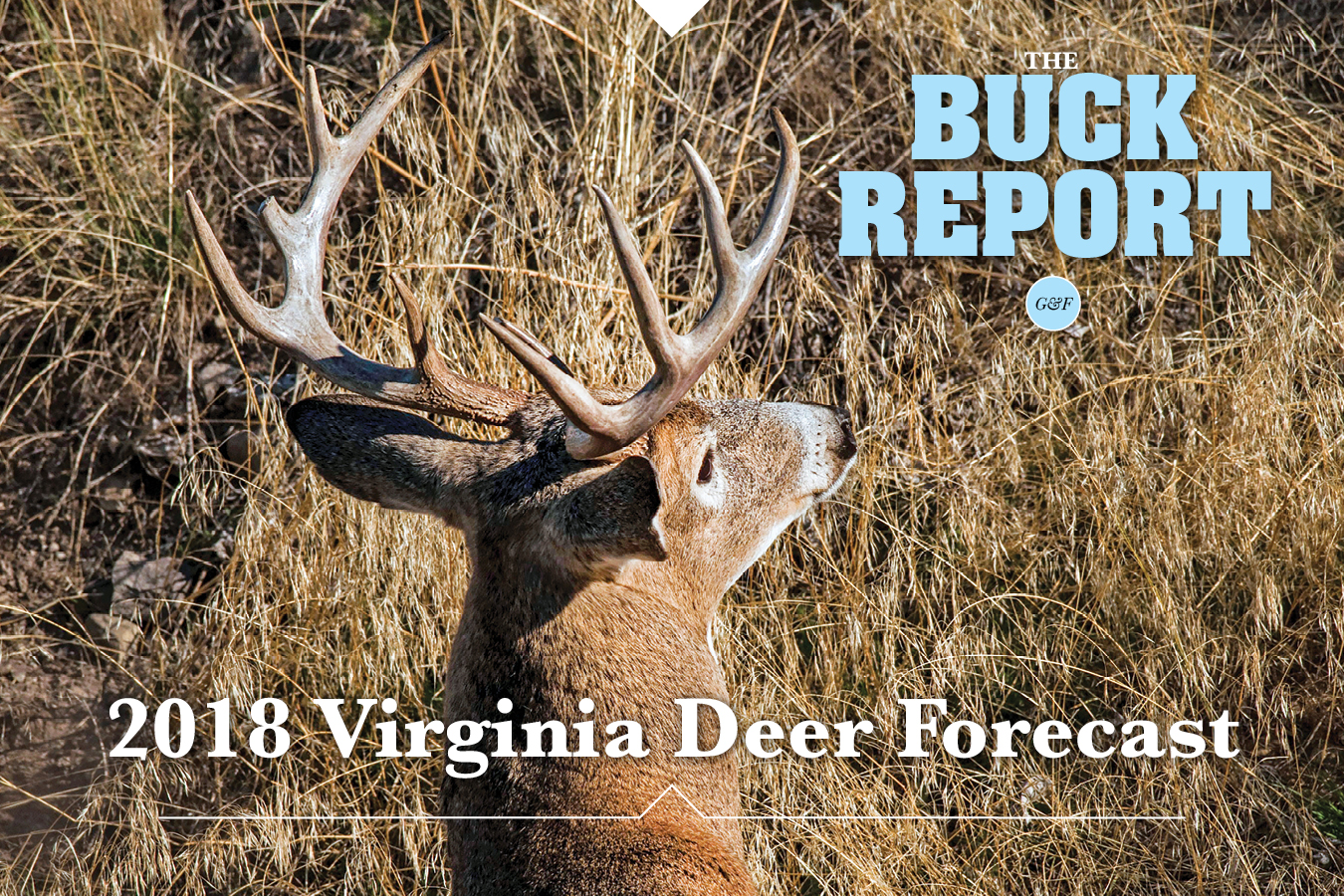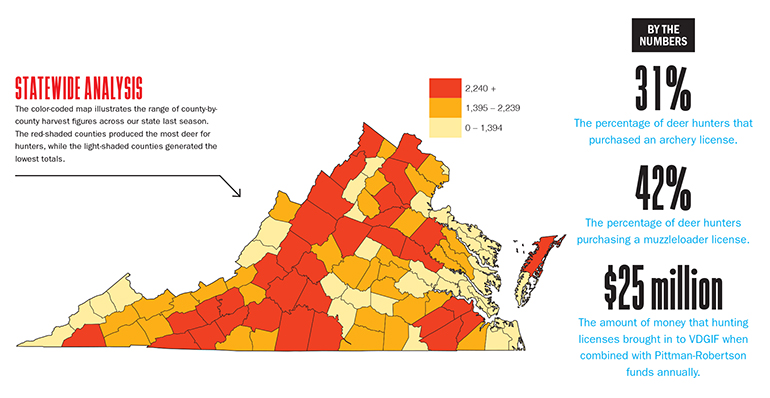
This detailed analysis of the Virginia deer picture will give you a realistic view of your 2018 hunting prospects.
Overall the deer harvest last year crept up approximately 5.5%, which is well within what biologists feel is a stable scenario. There are many factors that can impact harvest figures. Some of those include season changes, weather, mast crop, hunter participation, predation and disease.
It is quite a juggling act for deer biologists and managers to keep the herd at healthy levels, keep hunters happy and deal with the public’s concerns with regard to farmer complaints of deer eating crops, insurance companies upset with deer/vehicle collisions and landowners unhappy with deer eating their shrubbery, gardens or flowers.
DISEASE
Disease is certainly a factor that hunters need to educate themselves about. Chronic Wasting Disease (CWD) is a major concern as it has the ability to change the face of deer hunting (see sidebar). Last season, sixteen deer tested positive out of 1,500 tested. On the other hand, hemorrhagic disease (HD) is more prevalent, can cause immediate impacts to the deer population, and has been found all over the state.
The good news about HD is that although it can have very adverse effects on the deer population in the short term, the population bounces back if given proper management consideration by hunters and managers. Matt Knox, Virginia Division of Game and Inland Fisheries (VDGIF) Deer Project Coordinator, notes that last year was thankfully a quiet year with regard to HD in Virginia.

WEATHER
Weather overall was not a big factor in the hunting season last year. Sure, there were days that were not conducive to hunter participation, however, that is always going to be the case. The one notable exception that might have impacted the harvest were the last few days of the deer hunting season in January for much of the state. Those few days were bitterly cold, in fact, some dog clubs in my area of the state did not even drop dogs that final weekend because of the record breaking cold.
TIDEWATER
Last season the Tidewater deer harvest increased from 17,528 to 19,311. The upward tick was expected given that after HD hit the region hard several years ago. Biologists and deer managers restricted doe days the past few years which helped the herd rebound. HD was not much of an issue in 2017, which further helped hunters see and harvest more deer.
When looking closely at the harvest in this region, biologists note that when looking at the deer per square mile of habitat rankings, the Tidewater is well-represented with 5 of the top 20 counties on the list including Surry, Isle of Wight, Southampton, James City and Charles City.
Peter Acker, terrestrial biologist with VDGIF, noted that the region benefits from great habitat which includes balanced, fertile agriculture and managed forests or cutovers. Acker also said that clubs and managers are doing a good job actively adjusting their harvests based on desired results. This means that if hunters want more deer, they need to shoot fewer does. The doe harvest in the region has declined since 2014, which is allowing more deer overall. It appears that hunters and clubs are doing exactly what they need to do in order to increase the herd.
PIEDMONT
The deer harvest in the Southern Piedmont inched up from 22,755 to 23,894 last season. The doe harvest increased almost 2,000 animals. Only two counties made the top 20 list of deer harvested per square mile (Bedford and Cumberland), but don’t let that discourage you from hunting in this deer rich area. Bedford has a LOT of deer and has also swiped the top spot of total deer harvest numbers for the past five seasons. Private lands near agriculture, particularly edge habitat, is a great place to hunt.
SOUTHERN MOUNTAIN
The deer kill in the Southern Mountain Region increased noticeably this past season with 21,044 deer taken versus 18,783 the season prior. The doe harvest alone increased 2,033 from the previous season.
Some of this can be attributed to adding a week of doe days to the early muzzleloader season to help reduce the herd in Scott County, which is has a large population of deer on private lands. I asked Seth Thompson, VDGIF biologist, why Scott seems to have a healthy deer population, “The habitat is very productive with a mix of hard mast forests, lush river and creek bottoms and agriculture fields that are active and inactive. Both are great deer havens and food sources.”
Thompson went on to say that HD did make an appearance in Wise, Dickenson and Buchanan last year and managers and biologists are waiting to see how the herd responds.
OTHER
A cluster of counties has seen improved deer densities in recent years on private lands. Craig, Pulaski, Montgomery and Giles are all in the top twenty index of deer harvested per square mile. Grayson has been a reliable and consistent county to hunters on private land in the region too.
The harvest in the Northern Mountain Region was stable with a 5.8% increase from 13,843 to 14,708 deer taken. Top counties include Clarke and Frederick. These counties have very fertile soils and have a good mix of agriculture in crops and orchards on private lands with edge habitat dispersed among the fields. Good stands of mast bearing trees are the perfect supplement to the region’s deer habitat. Remember to check the regulations for the CWD Containment Area.
The harvest in the Northern Piedmont remained stable with a tiny tick downward from 16,766 in the previous season to 16,517 last season. However, the overall picture for hunters in this region is good. Six of the top 20 counties (Loudoun, Culpeper, Fauquier, Madison, Rappahannock and Orange) were from the region. Like the Northern Mountain Region, this region has great soils, plenty of agriculture, good hardwood stands, and it also had some timbering done in some of the south central counties. Timber harvests open up areas, create browse and thickets which help deer.
PARTING SHOT
The toughest thing that most Virginia deer hunters face is the shrinking amount of land that can be hunted. Competition for hunting rights/permission is high. VDGIF is adding WMA’s as fast as they can for public access and it helps, but pressure on public land hunting is high. The one exception would be the National Forest.
However, deer numbers on National Forest lands are very low and without hunters showing up at meetings, engaging their representatives to get the regulations and rules changed to allow more select or limited clear cutting on National Forest, the deer herd won’t improve much until the habitat improves. Hunters need to make connections with landowners and hunt clubs and work hard to keep them, so they have a place to hunt and a place to take their kids and family hunting.
Last, the General Assembly passed legislation permitting arrow guns for archers if the hunter has a disability form signed by a doctor on their person while hunting. During muzzleloader and firearms season the arrow guns are legal for all deer hunters.

Chronic Wasting Disease
Chronic Wasting Disease (CWD) is a fatal neurological disease that slowly kills deer. While currently CWD is known only to be present in far northwestern Virginia, it can very easily spread to other locations with transportation of the carcass or parts of an infected deer.
CWD is known to exist in 25 states and 2 Canadian Provinces. Mississippi is the latest state to find CWD in its deer herd, which was a bit of a surprise to some. Perhaps it should not be. QDMA recently published a map (qdma.com/this-cwd-map-spells-trouble-future-deer-hunting/) on its site. When looking at 32,000 deer killed in a portion of Wisconsin that had the highest incidence of CWD and the addresses of where those successful deer hunters resided, one can easily see that by transporting even a portion of banned carcasses back home the disease can spread all over the country. I was stunned to see a big red dot on that map not far from where I live in Virginia.
Past studies have not shown humans to be able to contract the disease. However, new studies are unclear about whether the disease can be transmitted. For this reason, some hunters are uncomfortable consuming deer that may be infected (infected deer are not obvious) and some have opted to hunt elsewhere.
The CDC strongly recommends deer harvested in CWD areas be tested and meat testing positive not be eaten. Virginia deer hunters that travel out of state need to be aware of and follow regulations if they are bringing deer back to Virginia. You can view these at: dgif.virginia.gov/wildlife/diseases/cwd/transporting-carcasses-into-and-out-of-va/.










